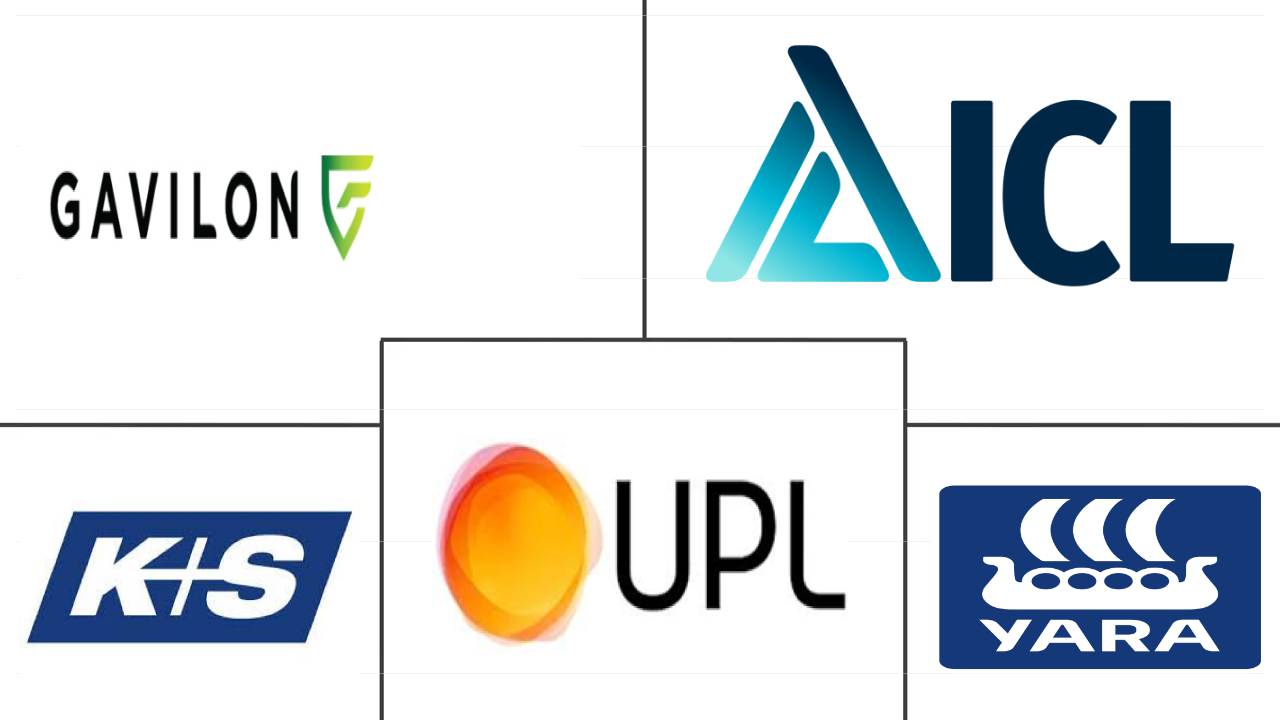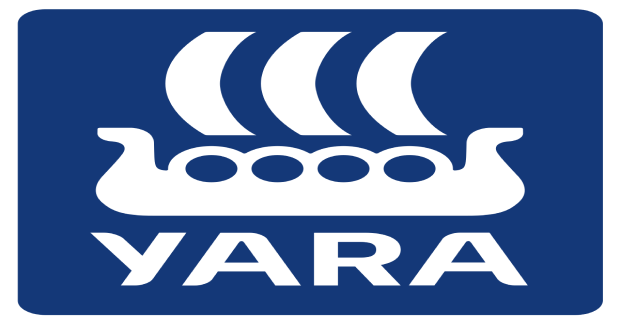Market Size of africa fertilizers Industry
|
|
Study Period | 2017 - 2030 |
|
|
Market Size (2024) | USD 14.57 Billion |
|
|
Market Size (2030) | USD 20.07 Billion |
|
|
Largest Share by Crop Type | Field Crops |
|
|
CAGR (2024 - 2030) | 5.49 % |
|
|
Largest Share by Country | Nigeria |
Major Players |
||

|
||
|
*Disclaimer: Major Players sorted in no particular order |
Africa Fertilizers Market Analysis
The Africa Fertilizers Market size is estimated at 14.57 billion USD in 2024, and is expected to reach 20.07 billion USD by 2030, growing at a CAGR of 5.49% during the forecast period (2024-2030).
14.57 Billion
Market Size in 2024 (USD)
20.07 Billion
Market Size in 2030 (USD)
7.13 %
CAGR (2017-2023)
5.49 %
CAGR (2024-2030)
Largest segment by Product
24.73 %
value share, Urea, 2023
The urea fertilizer market in Africa is witnessing an upward trajectory, with the advent of more environmentally friendly and efficient urea formulations.
Largest Segment by Crop Type
71.86 %
value share, Field Crops, 2023
Due to intensive cultivation and monoculture practices, field crops have depleted the nutrients in the soil. Thus, leading to higher fertilizer consumption in the region.
Fastest Growing Speciality Type
6.54 %
Projected CAGR, CRF, 2024-2030
High-value crops such as cash crops and turf & ornamental crops demand complex nutrient release patterns, which can be achieved using controlled release fertilizers.
Largest segment by Country
40.70 %
value share, Nigeria, 2023
Empirical studies show that Nigeria is still using fertilizers below 20kg/hectare, with the potential of applying more fertilizers, thus augmenting the market's growth.
Leading Market Player
4.03 %
market share, Yara International ASA, 2022

Yara International opened a USD 2.3 million liquid fertilizer plant in Malmesbury, South Africa to expand its production capacity and to exploit the agricultural potential.
The application of fertilizers in the respective crop types is anticipated to grow during 2023-2030, owing to the increasing need for food to feed the growing populations
- In 2022, field crops dominated fertilizer consumption in Africa, representing 71.1% of the total. This translated to a volume consumption of 15.5 million metric tons, valued at USD 11.80 billion.
- Horticultural crops followed, accounting for 28.7% of Africa's fertilizer consumption, valued at USD 4.77 billion in 2022. Despite a modest volume consumption of 9.0 thousand metric tons, the cultivation area for horticultural crops expanded from 36.5 million hectares in 2017 to 37.7 million hectares in 2022. This growth was driven by rising demand for high-value crops, such as fruits and vegetables, amidst concerns of hidden hunger and malnutrition. This surge in cultivation areas underscores the need for enhanced productivity, driving up fertilizer application in horticultural crops.
- Turf & ornamental crops, primarily driven by the demand for African flowers in international markets, accounted for 8.9% of Africa's fertilizer consumption in 2021. This translated to a market value of USD 770.6 million and a volume consumption of 1.5 million metric tons.
- However, in 2022, the share of turf and ornamental crops in Africa's fertilizer consumption dropped to a mere 0.02%. The market value for this segment was USD 3.5 million, with a volume consumption of 4.5 thousand metric tons. Conventional fertilizers dominated the market, capturing a 57.0% share, while specialty fertilizers accounted for the remaining 43.0%.
- The application of fertilizers across crop types is expected to rise. This growth is driven by the need to meet the food demands of a burgeoning population, achieve higher yields, and enhance crop productivity.
South Africa is one of the major agriculture-producing countries in the continent and is import-dependent
- Africa's vast mineral reserves of nitrogen, phosphate, and potash position it as a potential major player in the global fertilizer market. The region's rapid population growth, coupled with evolving food consumption patterns and rising incomes, is driving a need for increased agricultural production. This, in turn, is expected to lead to an increase in fertilizer demand.
- In 2022, Nigeria dominated the African fertilizer market, accounting for 36.7% of the total. Nigeria boasts one of the world's highest rice consumption rates, with an annual production of 7 million metric tons. The country's economic growth, primarily propelled by the agricultural sector, is projected to sustain a CAGR of 5.5% in the coming years.
- Despite being a major player, Nigeria's fertilizer usage remains relatively low, at under 20kg/hectare. This indicates a significant untapped potential for increased fertilizer application, potentially driving further market growth. In comparison, countries like Egypt and South Africa have already surpassed Nigeria's usage by a significant margin, suggesting a potential leap of around 500% for Nigeria to catch up.
- South Africa, a key agricultural nation in Africa, heavily relies on fertilizer imports. While all potassic fertilizers are domestically consumed, a substantial 60%-70% of nitrogenous fertilizers are imported. Unlike some other markets, South Africa's fertilizer sector operates in a deregulated landscape, devoid of import tariffs or government schemes. With a surge in crop cultivation, the South African fertilizer market is projected to witness substantial growth, expanding from USD 1.77 billion in 2022 to USD 5.60 billion by 2030.
Africa Fertilizers Industry Segmentation
Complex, Straight are covered as segments by Type. Conventional, Speciality, Specialty are covered as segments by Form. Fertigation, Foliar, Soil are covered as segments by Application Mode. Field Crops, Horticultural Crops, Turf & Ornamental are covered as segments by Crop Type. Nigeria, South Africa are covered as segments by Country.
- In 2022, field crops dominated fertilizer consumption in Africa, representing 71.1% of the total. This translated to a volume consumption of 15.5 million metric tons, valued at USD 11.80 billion.
- Horticultural crops followed, accounting for 28.7% of Africa's fertilizer consumption, valued at USD 4.77 billion in 2022. Despite a modest volume consumption of 9.0 thousand metric tons, the cultivation area for horticultural crops expanded from 36.5 million hectares in 2017 to 37.7 million hectares in 2022. This growth was driven by rising demand for high-value crops, such as fruits and vegetables, amidst concerns of hidden hunger and malnutrition. This surge in cultivation areas underscores the need for enhanced productivity, driving up fertilizer application in horticultural crops.
- Turf & ornamental crops, primarily driven by the demand for African flowers in international markets, accounted for 8.9% of Africa's fertilizer consumption in 2021. This translated to a market value of USD 770.6 million and a volume consumption of 1.5 million metric tons.
- However, in 2022, the share of turf and ornamental crops in Africa's fertilizer consumption dropped to a mere 0.02%. The market value for this segment was USD 3.5 million, with a volume consumption of 4.5 thousand metric tons. Conventional fertilizers dominated the market, capturing a 57.0% share, while specialty fertilizers accounted for the remaining 43.0%.
- The application of fertilizers across crop types is expected to rise. This growth is driven by the need to meet the food demands of a burgeoning population, achieve higher yields, and enhance crop productivity.
| Type | |||||||||||||||||||||||||||||||
| Complex | |||||||||||||||||||||||||||||||
|
| Form | ||||||
| Conventional | ||||||
| ||||||
| Specialty |
| Application Mode | |
| Fertigation | |
| Foliar | |
| Soil |
| Crop Type | |
| Field Crops | |
| Horticultural Crops | |
| Turf & Ornamental |
| Country | |
| Nigeria | |
| South Africa | |
| Rest of Africa |
Africa Fertilizers Market Size Summary
The Africa Fertilizers Market is poised for significant growth, driven by the increasing demand for agricultural productivity to meet the needs of a rapidly growing population. The market is characterized by a diverse range of crop types, with field crops such as corn, sorghum, wheat, and rice dominating fertilizer consumption. The region's vast mineral reserves of nitrogen, phosphate, and potash position Africa as a potential major player in the global fertilizer industry. The expansion of cultivation areas for high-value crops, such as fruits and vegetables, is further propelling the demand for fertilizers, as concerns over food security and malnutrition rise. Despite the growth, the market remains fragmented, with a few key players holding a modest share, indicating opportunities for further consolidation and expansion.
Nigeria stands out as a significant contributor to the African fertilizer market, yet it faces challenges with low fertilizer usage per hectare, suggesting untapped potential for growth. South Africa, on the other hand, relies heavily on fertilizer imports, particularly nitrogenous fertilizers, and operates in a deregulated market environment. The market's growth is also influenced by shifts in crop cultivation patterns, such as the pivot from corn to oilseed crops in response to market dynamics. The ongoing strategic partnerships and acquisitions among major players, like K+S and ICL, highlight the industry's focus on expanding operations and enhancing product offerings to meet the evolving agricultural demands across the continent.
Africa Fertilizers Market Size - Table of Contents
-
1. MARKET SEGMENTATION (includes market size in Value in USD and Volume, Forecasts up to 2030 and analysis of growth prospects)
-
1.1 Type
-
1.1.1 Complex
-
1.1.2 Straight
-
1.1.2.1 Micronutrients
-
1.1.2.1.1 Boron
-
1.1.2.1.2 Copper
-
1.1.2.1.3 Iron
-
1.1.2.1.4 Manganese
-
1.1.2.1.5 Molybdenum
-
1.1.2.1.6 Zinc
-
1.1.2.1.7 Others
-
-
1.1.2.2 Nitrogenous
-
1.1.2.2.1 Ammonium Nitrate
-
1.1.2.2.2 Urea
-
1.1.2.2.3 Others
-
-
1.1.2.3 Phosphatic
-
1.1.2.3.1 DAP
-
1.1.2.3.2 MAP
-
1.1.2.3.3 SSP
-
1.1.2.3.4 TSP
-
-
1.1.2.4 Potassic
-
1.1.2.4.1 MoP
-
1.1.2.4.2 SoP
-
-
1.1.2.5 Secondary Macronutrients
-
1.1.2.5.1 Calcium
-
1.1.2.5.2 Magnesium
-
1.1.2.5.3 Sulfur
-
-
-
-
1.2 Form
-
1.2.1 Conventional
-
1.2.2 Speciality
-
1.2.2.1 CRF
-
1.2.2.2 Liquid Fertilizer
-
1.2.2.3 SRF
-
1.2.2.4 Water Soluble
-
-
1.2.3 Specialty
-
-
1.3 Application Mode
-
1.3.1 Fertigation
-
1.3.2 Foliar
-
1.3.3 Soil
-
-
1.4 Crop Type
-
1.4.1 Field Crops
-
1.4.2 Horticultural Crops
-
1.4.3 Turf & Ornamental
-
-
1.5 Country
-
1.5.1 Nigeria
-
1.5.2 South Africa
-
1.5.3 Rest of Africa
-
-
Africa Fertilizers Market Size FAQs
How big is the Africa Fertilizers Market?
The Africa Fertilizers Market size is expected to reach USD 14.57 billion in 2024 and grow at a CAGR of 5.49% to reach USD 20.07 billion by 2030.
What is the current Africa Fertilizers Market size?
In 2024, the Africa Fertilizers Market size is expected to reach USD 14.57 billion.

